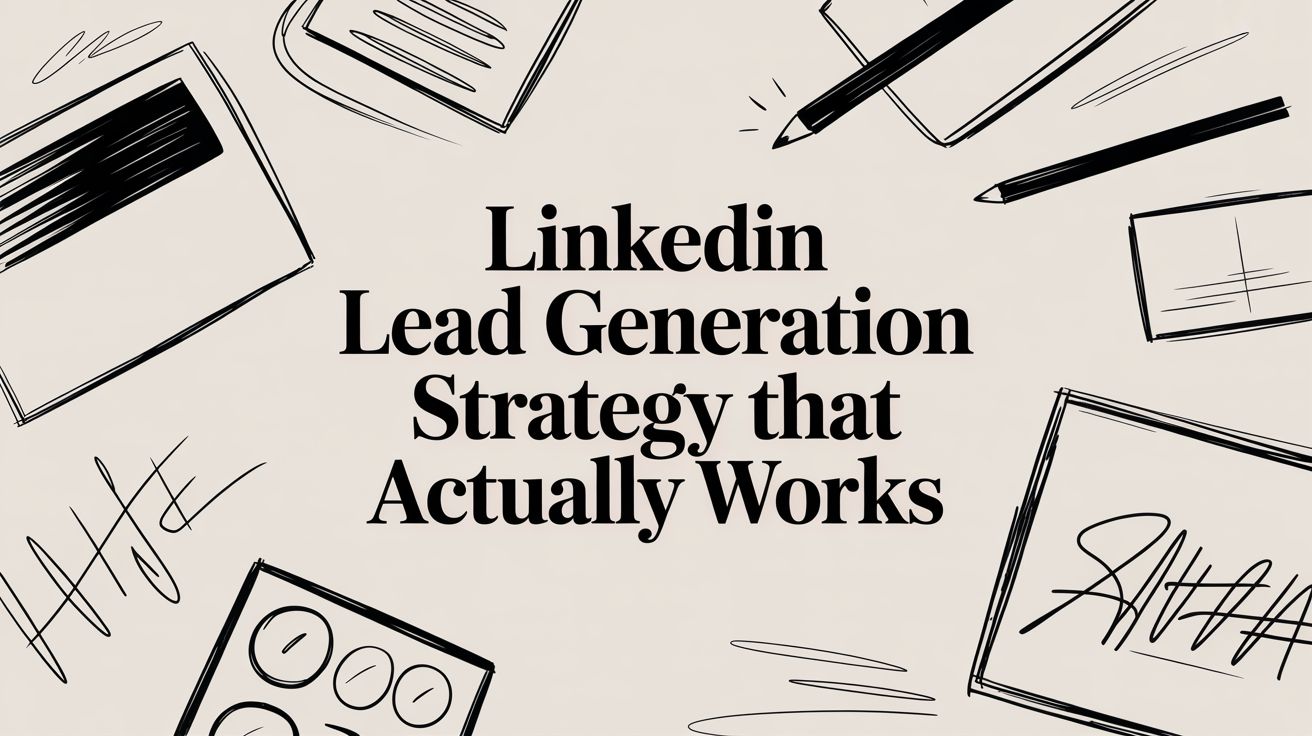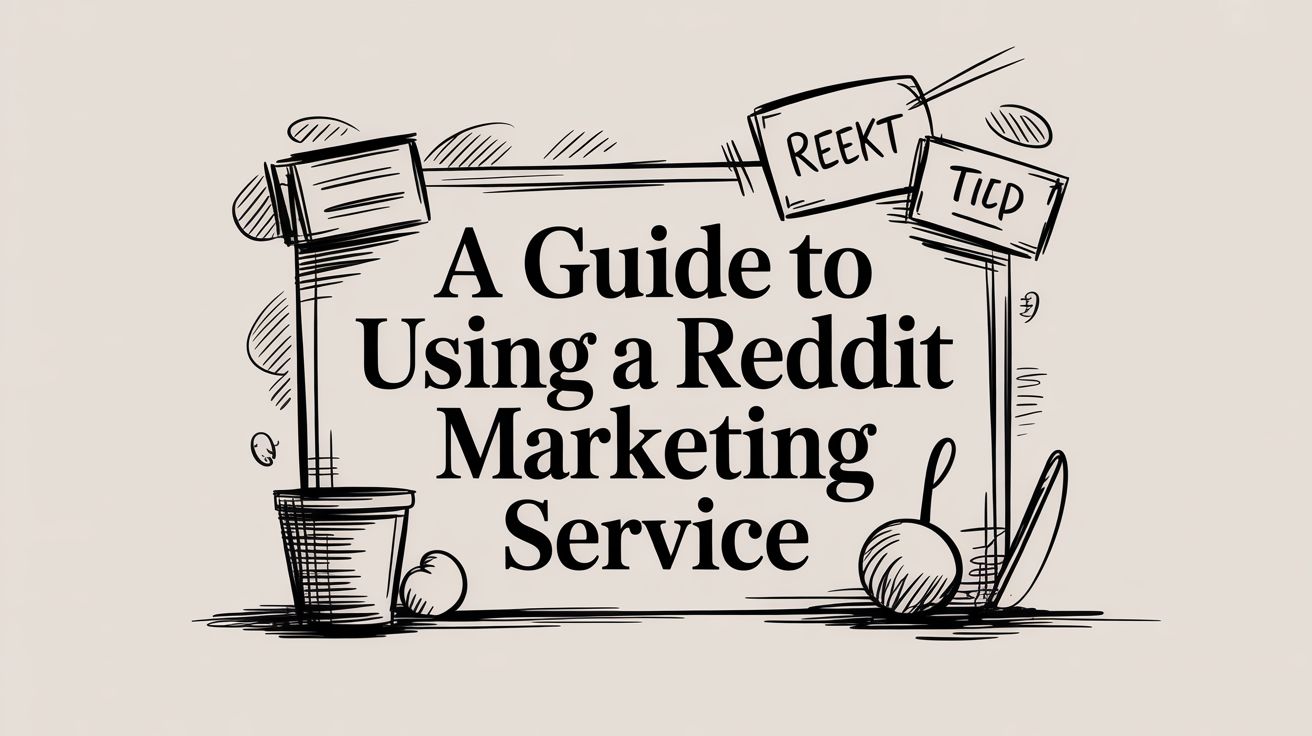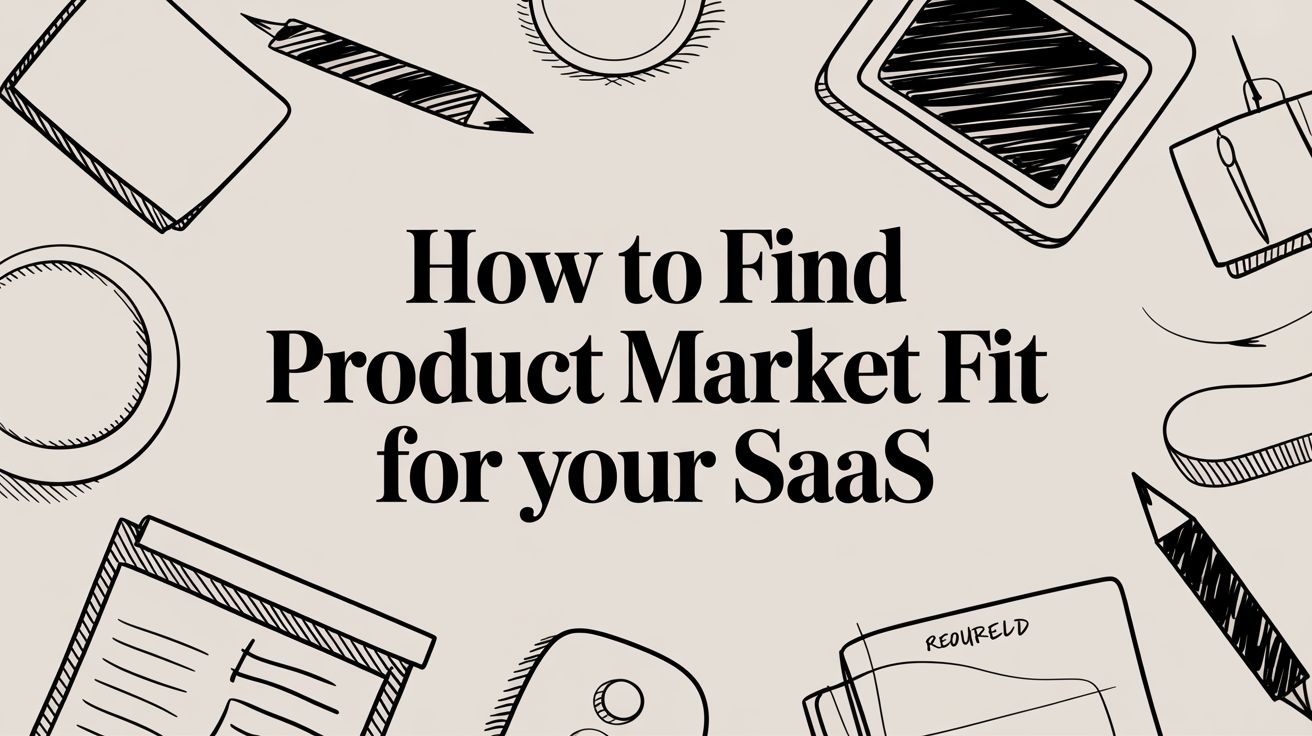A winning LinkedIn lead-generation plan starts long before you craft that first message. It relies on a fully optimized, customer-centric profile and Company Page—two halves of a single engine that pulls in your ideal prospects. Skip this groundwork, and your outreach will feel like background noise instead of an invitation.
Build Your Foundation For LinkedIn Success
Your profile isn’t a static resume; it’s a dynamic sales page. Every section, from headline to “About,” should speak directly to your target audience’s biggest challenges and position you as the go-to solution.
The stakes are high. LinkedIn’s member count jumped from 644 million in 2019 to an expected 1.15 billion by 2025. Revenue crossed $16.37 billion in 2024 alone. For more on how this growth is reshaping B2B selling, see Sprout Social.
Optimize Your Personal Profile First
Your personal profile is where you spark conversations—connection requests, comments, messages all come from here.
Craft a Customer-Focused Headline:
Swap “Sales Director at SaaS Company” for “Helping B2B Founders Cut Churn by 30% with Data Analytics.”Write a Benefit-Driven Summary:
Use the “About” section to tell your story. Call out a common pain point, then explain exactly how you solve it in plain language.Use a Professional Headshot and Banner:
Choose an approachable headshot and a banner that highlights a core benefit—client testimonial, value proposition, or a specific call to action.
Don’t Neglect Your Company Page
Your Company Page is the proof point prospects look to after they click “Connect.” It should feel like a living brochure—complete, current, and packed with reasons to trust you.

That image demonstrates how a polished Company Page becomes a central content hub and magnet for leads. Key elements include:
- Clear service descriptions that match your audience’s needs
- Engaging articles, posts, and visuals that showcase expertise
- Testimonials or team highlights for instant social proof
For even more ideas, check out these additional proven LinkedIn lead generation strategies.
Key Takeaway: Your LinkedIn presence is a two-part system. Your personal profile starts the conversation, and your Company Page validates your credibility. Neglecting either one weakens your entire lead generation effort. Our guide on how to generate B2B leads provides further context on building these foundational elements.
Your Content Is the Engine of Your LinkedIn Strategy
Think of your content as the fuel for your entire LinkedIn lead generation machine. It's what draws people in, warms them up, and gets them interested long before you ever think about sending a connection request. If you're just posting corporate updates or product announcements, you're missing the point. The real goal is to share content that genuinely helps your audience solve their biggest headaches.
This isn't about creating one massive, viral post. The reality is, most buyers will check out 5-7 pieces of your content before they even consider talking to you. Your mission is to make sure each one of those pieces adds real value and is easy for them to find.
Build Your Content on Solid Pillars
Before you write a single word, you need to define your content pillars. These are the 2-4 core themes that directly relate to your ideal customer's most significant challenges. These pillars are your North Star, keeping every post, article, and carousel you create focused and relevant.
Let's imagine you're a SaaS company with a project management tool. Your pillars might look something like this:
- Boosting Team Productivity: This could be anything from tips on running shorter meetings to deep dives into specific workflow automations.
- Mastering Remote Collaboration: Here, you'd share advice on keeping distributed teams in sync, motivated, and on track.
- Data-Driven Project Management: This pillar focuses on teaching people how to use metrics to get better project results.
When you stick to these themes, you're not just another software company spamming features. You're consistently proving you understand your audience's world, which is how you transition from being a vendor to becoming a go-to advisor.
Mix Up Your Content Formats
A great LinkedIn strategy is never a one-trick pony. Relying only on text posts is a surefire way to get lost in the noise. Different people prefer to consume information in different ways, so a varied approach is key to keeping your audience hooked.
Try blending these formats into your weekly plan:
- Quick-Hit Text Posts: These are short, punchy posts (think under 200 words) that share a single powerful tip, a controversial take on an industry trend, or a relatable personal story. They're built for sparking conversation in the comments.
- Carousels (PDFs): People love to swipe. Use carousels to break down a complex idea into bite-sized, visual steps. They're perfect for turning an old blog post into fresh content, sharing a helpful checklist, or illustrating a process.
- LinkedIn Articles: When you need to go deep on a topic, use LinkedIn's native article feature. This is your space to establish true thought leadership, publish a detailed case study, or lay out a comprehensive solution to a major industry problem.
My Two Cents: Stop selling and start storytelling. The content that performs best almost always has a human element. Talk about a time you messed up and what you learned. Detail a specific client's struggle and walk through the exact steps you took to get them a win. People trust authenticity far more than a polished sales pitch.
By weaving these different formats together, you create a content experience that works for everyone—from the skimmers to the deep divers. Each piece of content you publish acts like a breadcrumb, guiding potential customers one step closer to wanting to have a real conversation with you.
Master Your Targeted Outreach and Engagement
Alright, you've polished your profile and your company page is looking sharp. That's the foundation. Now, it's time to actually start conversations and generate leads. This is where we move from passively attracting viewers to actively engaging the right people in a way that feels helpful, not spammy.
Forget about blasting out generic connection requests. We're going to build a smart, targeted outreach workflow. It starts with finding the perfect prospects and moves into a thoughtful messaging cadence that builds real rapport long before you ever ask for a meeting.
Build Hyper-Targeted Lead Lists
Your outreach is only as good as the list you're working from. Seriously. This is where LinkedIn Sales Navigator becomes your best friend. It lets you slice and dice LinkedIn’s massive database to find your ideal prospects with incredible precision.
Don't just stop at job titles. You need to layer filters to get to the people who are most likely to buy.
- Company Size & Industry: First, make sure you're talking to companies that actually fit your ideal customer profile (ICP).
- Job Roles & Seniority: Next, zero in on the specific decision-makers and influencers within those target accounts.
- Recent Activity (Buying Signals): This is the secret sauce. Filter for people who have changed jobs in the last 90 days or are actively posting about topics related to your solution. These are huge buying signals.
As you get comfortable with the basics, you can explore more advanced LinkedIn prospecting methods to keep your pipeline full of high-quality leads.
A solid content strategy supports this outreach by educating and engaging your audience, essentially warming up your cold outreach before you even send it.
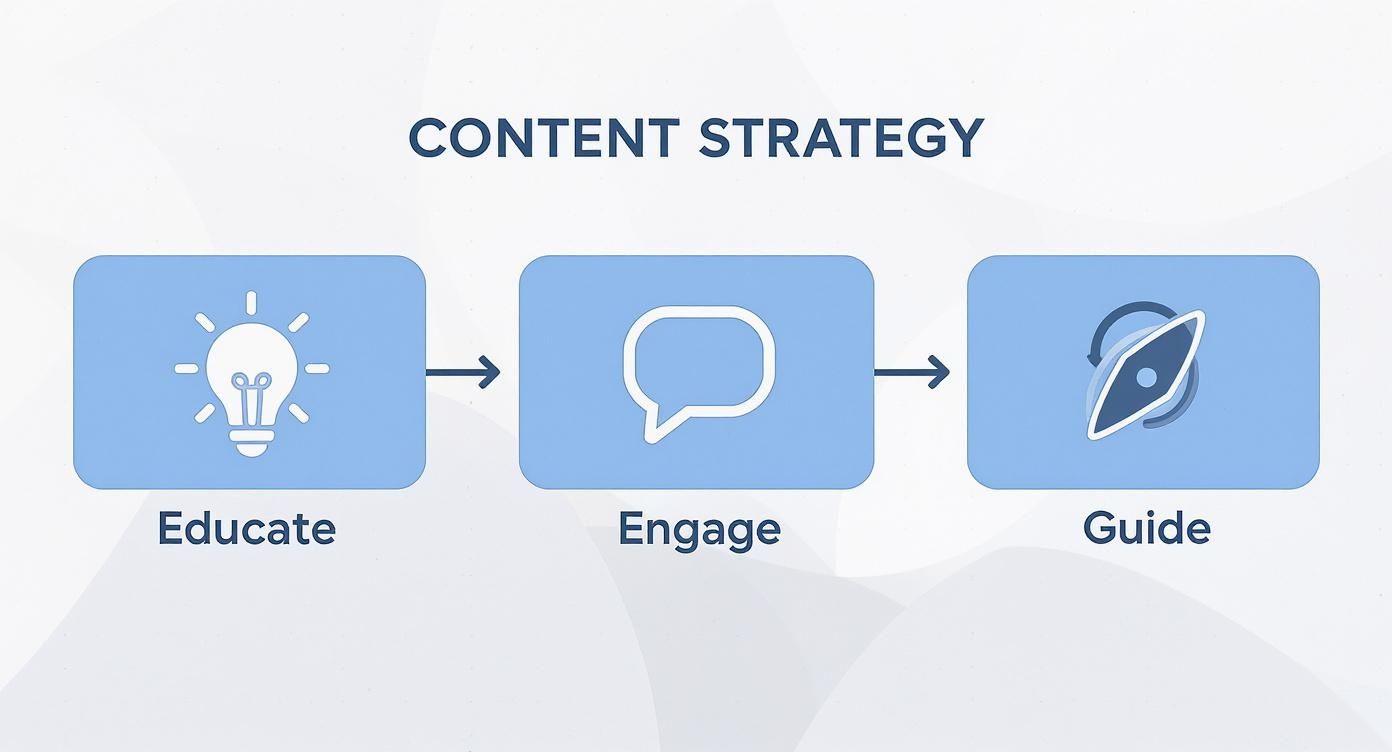
Think of it as a multi-step conversation where you're providing value at every single touchpoint.
Craft Connection Requests That Actually Get Accepted
Your connection request is your first impression. If you use the default "I'd like to add you to my professional network," you might as well be invisible. You have to give people a reason to click "Accept."
A request that works almost always has a personal, relevant hook. Here are a few angles that I’ve seen work time and time again:
- The Mutual Connection: "Hi [Name], I saw we're both connected with [Mutual Connection's Name] and thought it made sense to reach out."
- The Content Compliment: "Hi [Name], really enjoyed your recent post on [Topic]. Your point about [Specific Detail] was spot on."
- The Common Ground: "Hi [Name], I see we're both members of the [LinkedIn Group Name] group and wanted to connect with other folks in the space."
This simple, personalized approach is the heart of what we call social selling. If you want to dive deeper into this, we have a whole guide on social selling for B2B that breaks it down.
Key Insight: The only goal of a connection request is to get accepted. That’s it. Don’t sell, don’t pitch, don’t ask for a meeting. Just make a small, relevant, human connection to open the door.
This isn't just theory; the numbers back it up. We’ve seen that messaging on LinkedIn gets an average reply rate of 85%—that's three times higher than your average cold email campaign. Sending just 30-45 tailored connection requests per day can net you an acceptance rate around 45%, which dramatically accelerates your lead generation.
Nurture New Connections Before You Pitch
Okay, they accepted. What now? The biggest mistake people make is pouncing with a sales pitch immediately. That’s a surefire way to get ignored, or worse, removed as a connection.
Instead, you need a nurturing cadence. Give the new relationship some room to breathe and provide value first.
Below is a simple, 4-step cadence that you can adapt. The goal is to build familiarity and trust before you ever ask for someone’s time.
Sample LinkedIn Outreach Messaging Cadence
This 4-step messaging sequence is designed to build rapport and generate qualified meetings without being pushy. This cadence can be adapted for different target personas.
| Day | Action | Message Focus |
|---|---|---|
| 1 | Connection Accept | Send a simple "Thanks for connecting!" message. No pitch. Maybe ask a soft, open-ended question. |
| 3 | Provide Value | Share a genuinely helpful article, case study, or resource relevant to their industry or role. |
| 7 | Gentle Nudge | Comment on one of their posts or share a quick insight related to something they've shared. |
| 10 | The "Ask" | Transition the conversation toward a potential problem you can solve and ask for a brief call. |
This patient, value-first strategy is what separates the spammers from the expert sellers. It's how you turn a brand-new connection into a genuinely qualified sales meeting.
Find Your Next Best Leads in Conversations and Communities
While a solid outreach plan is essential, I've found that some of the absolute warmest leads aren't from cold messages at all. They come from conversations already happening all over LinkedIn.
The big shift here is moving from pushing messages to pulling prospects in. You do this by showing up where your ideal customers are talking about their problems and positioning yourself as the helpful expert they’ve been looking for. It's a fundamental part of a modern B2B playbook—be present, be valuable, and be human.
Become a Fixture in Niche LinkedIn Groups
LinkedIn Groups can be a total goldmine, but only if you play it smart. The quickest way to get kicked out or completely ignored is to jump in and start pitching. Don't be that person. Your goal is to become a trusted, go-to voice in the community.
First, find your turf. Identify 3-5 highly relevant, active groups where your target audience hangs out. The key word here is active. You're looking for communities with daily posts and, even more critically, comment sections that are actually buzzing with conversation.
Once you’re in, your job is to contribute, not to sell.
- Answer questions: When someone posts a question you have a good answer for, jump in with a genuinely helpful, detailed response right in the comments. No pitching.
- Share great content (that isn't yours): Found an insightful industry report or a killer article? Post it in the group and ask a question to get a discussion going. It shows you’re there to add value, not just to take.
- Engage with others: A thoughtful comment on someone else’s post goes a long way. It builds rapport and keeps you visible without being pushy.
Do this consistently, and you build serious trust. Over time, people start to recognize your name and associate it with expertise. That makes them incredibly receptive when you finally do connect, or better yet, they'll come looking for you when they need help.
Master the Art of Strategic Commenting
Groups are great, but don't forget that your prospects and key industry players are posting on their own feeds every single day. Getting on their radar is as simple as leaving a smart comment.
But let's be clear—a "Great post!" or "I agree!" is completely useless. You have to add something to the conversation. Challenge a point (respectfully!), share a related experience, or ask a thoughtful follow-up question.
For instance, say a prospect posts about their team’s struggle with productivity. Instead of a generic reply, try something like this:
"This is a huge challenge. One thing we've seen work is implementing a 'deep work' block for two hours every morning—no meetings, no notifications. Have you experimented with anything similar? Curious to know what the impact was."
A comment like this is a triple-win.
- It proves you actually read the post and didn’t just scan the headline.
- It gives away a piece of value for free, asking for nothing in return.
- It perfectly tees up a natural conversation you can continue in their DMs later.
This tactic flips the entire dynamic on its head. Your first touchpoint isn't a cold, self-serving pitch. It's a warm, relevant exchange where you're seen as a knowledgeable peer, not just another sales rep.
Measure and Scale Your LinkedIn Performance
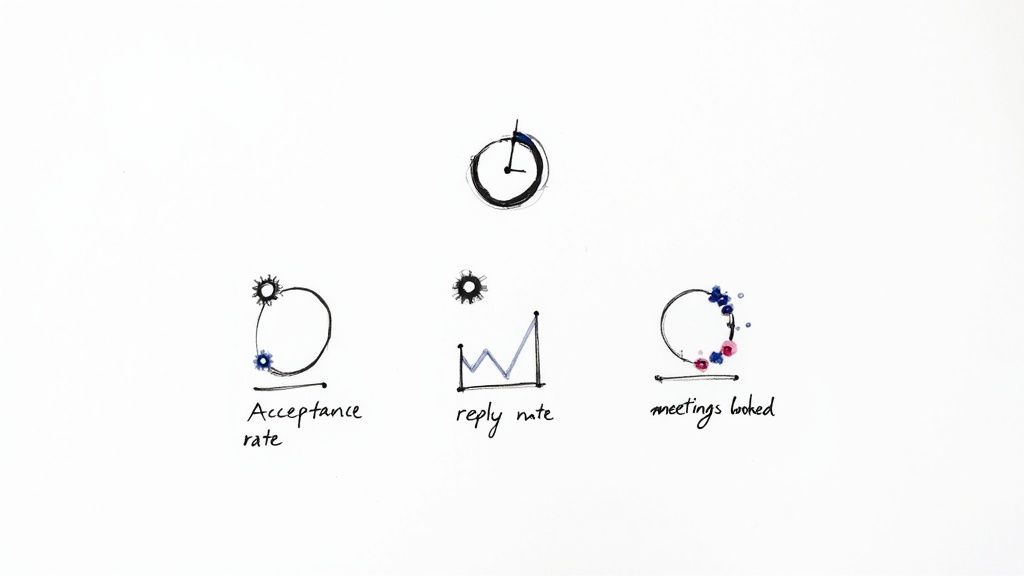
Let's be honest: without tracking your results, your LinkedIn strategy is just a shot in the dark. To build a reliable machine that brings in new business, you have to know what's working so you can do more of it. It’s about turning random acts of outreach into a system you can count on.
And this isn't just a "nice-to-have." By 2025, a staggering 89% of B2B marketers were already on LinkedIn for lead generation. More importantly, 40% of them called it their single most effective channel for finding high-quality leads. That's why being meticulous about measurement isn't optional; it's what separates the pros from the amateurs.
Define Your Key Performance Indicators
You can't fix what you can't see. It’s easy to get distracted by vanity metrics like profile views, but you need to zero in on the numbers that actually move the needle for your business. These are your Key Performance Indicators (KPIs).
Here are the core metrics I always tell my team to watch:
- Connection Acceptance Rate: What percentage of your connection requests get accepted? If this number is dipping below 20-30%, it's a huge red flag. It usually means your profile isn't compelling or your connection messages are too generic.
- Reply Rate to First Message: After someone accepts your request, how many actually reply to your first message? This is a gut check on your messaging. Are you providing immediate value, or just pitching?
- Meetings Booked: This is the bottom line. How many conversations are turning into actual demos or sales calls? This is the ultimate test of your entire process.
Keeping a close eye on these numbers tells you the real story. A good social media analytics dashboard can pull all this data into one place, making it much easier to see trends and find bottlenecks before they become major problems.
A quick tip: Your LinkedIn Social Selling Index (SSI) is a great diagnostic tool, but don't treat it as a primary KPI. Think of its four parts—establishing your brand, finding the right people, engaging with insights, and building relationships—as a report card for your process. It helps you see where you're weak.
Use Automation Tools Wisely
Scaling your LinkedIn efforts shouldn't mean chaining yourself to your desk for 12 hours a day. The smart way to scale is by letting technology handle the boring, repetitive stuff so you can focus on what humans do best: building relationships.
The trick is to automate the actions, not the relationships.
Look for tools that can safely take over tasks like:
- Visiting profiles to get on your prospects' radar.
- Sending connection requests based on a hyper-targeted Sales Navigator search.
- Running simple follow-up sequences to stay top of mind with new connections.
Think of these tools as your virtual assistant. They free you up to do the high-impact work—writing thoughtful, personalized messages and jumping into meaningful conversations in the comments. This blend of sharp data and smart automation is how you truly scale a lead generation strategy that works.
Common LinkedIn Lead Generation Questions
Diving into LinkedIn lead generation often brings up practical concerns. Getting clear answers keeps you moving forward without stumbling over avoidable missteps.
Here are the questions I hear most from teams building a reliable pipeline on LinkedIn.
How Much Time Should I Dedicate Daily
You don’t need to live on LinkedIn to get traction. A short, consistent routine beats sporadic marathons every time.
Aim for 30–60 minutes of focused activity each day. Treat it like a daily workout for your network—purposeful, with measurable goals.
- 15 Minutes: Send new, personalized connection requests to prospects.
- 15 Minutes: Respond to incoming messages and nurture conversations.
- 15 Minutes: Comment on posts from your target audience and industry leaders.
- 15 Minutes: Share one of your own insights or check in on active groups.
This breakdown ensures you cover all the bases without letting LinkedIn dominate your schedule.
Can I Automate Everything
No tool will ever replace genuine human interaction—and you shouldn’t want it to. Sure, you can automate profile visits or initial connection requests, but go too far and you risk restrictions…or worse, losing credibility.
Key Takeaway: Automate the tasks, not the relationships. A bot can’t craft a comment that references a shared challenge or recall a detail from an earlier conversation. Your authentic voice remains your biggest edge.
What Is the Biggest Outreach Mistake to Avoid
Nothing kills a new connection faster than an instant sales pitch. It feels like cornering someone at a conference, shoving a demo in their face.
Instead, start with value. Your very first message should be a thank-you note, a question about their recent post, or a helpful resource. Give the relationship room to grow before you ever drop your offer. That patient, value-first approach is the bedrock of any successful LinkedIn strategy.
Ready to turn conversations into customers without the manual grind? Replymer uses real writers to find the right discussions and share your expertise on LinkedIn, X, and Reddit, bringing qualified inbound leads to your door. See how it works at Replymer.
